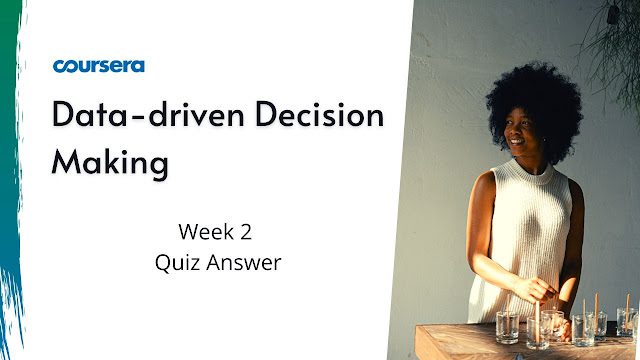Data-driven Decision Making Week 2 Quiz Answers
In this article i am gone to share Coursera Course Data-driven Decision Making Week 2 Quiz Answers with you..
Data-driven Decision Making
Week 2 Quiz Answers
Also visit this link: Data-driven Decision Making Week 1 Quiz Answers
Quiz 2 Answers
Question 1)
What is the term used to describe data sets that are so large and complex that they become difficult to process using traditional data processing applications?
- Big data
- Quantitative data
- Open source data
- Unstructured data
Question 2)
A client presents you with data sets for analysis. These sets are well defined and include customers names, ages, and other identifying data. What type of data is this?
- Structured
- Unstructured
- Semi-structured
Question 3)
The client presents you with another set of data. This data is a compilation of all of the comments made on their social media page for the last six months. What type of data is this?
- Unstructured
- Structured
- Semi-structured
Question 4)
The client gives you all the email communication they have received in the last six months that have included the words “complaint,” “manager,” or “dissatisfied.” What type of data is this?
- Structured
- Unstructured
- Semi-structured
Question 5)
How can an organization help ensure that they are using social media data properly?
- By using predictive modeling to look at what might happen in the future
- By making sure they are gathering data from more than one social media platform
- By having a strategy that ties the data back to other relevant data sets to validate findings
Question 6)
What are 3 major business implications of technology advancements?
- Supply chains are more complex and diverse
- Time to market products and services has increased
- There is more feedback generated by social media
Question 7)
What are the business benefits from advanced data and analytics? Select all that apply.
- Increased revenues and profits as companies look at hyper-targeting customers
- Reduced risk and better quality as standardization and automation become the norm.
- Decreased costs and enhanced productivity as more automation takes over from human decision making
- Better customer experience as the omni-channel interactions provides the convenience for customers and the low cost for providers
Question 8)
Which statement most accurately describes PwC’s perspective on big data?
- The tools we have available to us now creates a situation where we are able to analyze large amounts of data very quickly.
- Big data is about how insights from data can drive big decisions that solve real business issues and create innovation and opportunity.
- Big data provides so much information that organizations cannot possibly keep up unless they have the most current technology for processing data.
Question 9)
Why is it important to use both primary and secondary data in building strategic decisions?
- Primary data gives you user-generated content while secondary data gives you industry benchmarks.
- Primary data is data that you have collected and secondary data is data that you obtain from an another source / study.
- Primary data tells you what consumers plan to do and secondary data tells you what they actually did.
- Primary data is more reliable than secondary data since you observed it first hand, but secondary has been validated by a third party.

